Effect of Ti-B Grain Refiners on Wear and Corrosion of the A332 Alloy with Sr Modification
Abstract
1. Introduction
2. Materials and Methods
2.1. Metallographic Characterization and Mechanical Testing
2.2. Ball-on-Disk Wear Testing
2.3. Corrosion Analysis
3. Results
3.1. Microstructure Characterization
3.2. Primary Aluminum Phase Grain Size and Hardness
3.3. Nanoindentation Analyses
3.4. Effect of Grain Refiner Addition on Wear Behavior
3.5. Corrosion Analysis
4. Discussion
4.1. Microstructure Characterization
4.2. Primary Aluminum Phase Grain Size and Hardness
4.3. Effect of Grain Refiner Addition on Wear Behavior
4.4. Corrosion Analysis
5. Conclusions
- Effective dispersion of grain refinement was achieved when using the melting temperature of 750 °C. The procedure adopted can be used to insert the Al5Ti1B and Al5Ti2B master alloys in the A332 alloy with an induction furnace.
- The morphology of elongated arms of dendrites of primary aluminum changes to more equiaxed grains when the grain refiners (Al5Ti1B or Al5Ti2B) are added. This modification of the shape and size of the grains results from increasing the formation of solidification nuclei through different refining utilized. Furthermore, the image analysis allowed a note of the modifications from acicular-shaped to lamellar due to the presence of the Sr modifier.
- The fundamental function of the grain refiner was successfully obtained using both master alloys. The grain refiners (Al5Ti2B and Al5Ti1B) are adequate to achieve smaller grain sizes for the A332 aluminum alloy compared to as-cast conditions, probably promoting adequate places for heterogeneous nucleation. Al5Ti1B was the most effective grain refiner, reducing (33.3 ± 3.3 μm) in comparison with Al5Ti2B (38.8 ± 4.4 μm).
- The average hardness increased after adding grain refiner due to the Hall–Petch relation and Fe-based intermetallic phase length increases. Albeit the non-homogeneous grain size through the samples led to a significant variation in the values of the standard deviation factor. Hence, it is not possible to confirm if there is any improvement in microhardness with the addition of different refiners.
- In the combined addition of grain refiner and modifier samples, Fe-based intermetallic phase measurements indicate an increase in the phase length. The Al5Ti2B condition presents volumetric fraction values (4.2 ± 0.74%) slightly higher than the other (Al5Ti1B), around 3.6 ± 1,45%. This higher fraction of could be responsible for the slight difference in the wear resistance. The data index obtained from the nanoindentation analysis shows a relation with the higher resistance to the wear of the phase.
- Addition of grain refiners improved the relative wear resistance. Although the difference between them is modest because the values are 1.359 to Al5Ti2B and 1.353 to Al5Ti1B, both values are higher to those of the as-cast condition (1), used as a reference. The observed effect might be linked to a refinement and an increase in the length of the intermetallic particles , which would be related to the improved wear resistance of the aluminum alloy A332.
- A relation between corrosion resistance and addition of grain refiner cannot be established. While Al5Ti2B has shown an overall decrease in corrosion resistance, Al5Ti1B has an enhanced performance. Nonetheless, pitting morphology should be considered before the use of grain refinement. Although the pitting formation started at a higher corrosion potential with the use of grain refiners, the optical microscopy images have shown deeper pits. Furthermore, the phase acts as a cathodic function in the corrosion reaction, dissolving the adjacent matrix, primary aluminum, and generating pit growth.
Author Contributions
Funding
Institutional Review Board Statement
Informed Consent Statement
Data Availability Statement
Acknowledgments
Conflicts of Interest
References
- Zhang, H.; Chen, G.; Zhang, Z.; Zhao, Y.; Mu, S.; Xu, J.; Zhang, T. Study on the Grain Refinement of A356 Alloy by Al–3 Wt-% VN Master Alloy. Mater. Sci. Technol. 2020, 36, 819–826. [Google Scholar] [CrossRef]
- Zhu, M.; Jian, Z.; Yang, G.; Zhou, Y. Effects of T6 Heat Treatment on the Microstructure, Tensile Properties, and Fracture Behavior of the Modified A356 Alloys. Mater. Des. 2012, 36, 243–249. [Google Scholar] [CrossRef]
- Nogita, K.; Dahle, A.K. Effects of Boron on Eutectic Modification of Hypoeutectic Al–Si Alloys. Scr. Mater. 2003, 48, 307–313. [Google Scholar] [CrossRef]
- Yan, W.; Fu, G.; Xu, Y.; Lai, W.; Chen, H. Effect of Sr Addition on the Microstructure and Properties of the A356 Al Alloy. Mater. Tehnol. 2021, 55, 443–448. [Google Scholar] [CrossRef]
- Prema, S.; Chandrashekharaiah, T.M.; Farida Begum, P. Effect of Grain Refiners and/or Modifiers on the Microstructure and Mechanical Properties of Al-Si Alloy (Lm6). Mater. Sci. Forum 2019, 969, 794–799. [Google Scholar] [CrossRef]
- Rakhmonov, J.; Timelli, G.; Bonollo, F. Influence of Melt Superheat, Sr Modifier, and Al-5Ti-1B Grain Refiner on Microstructural Evolution of Secondary Al-Si-Cu Alloys. Metall. Mater. Trans. A 2016, 47, 5510–5521. [Google Scholar] [CrossRef]
- Samuel, E.; Golbahar, B.; Samuel, A.M.; Doty, H.W.; Valtierra, S.; Samuel, F.H. Effect of Grain Refiner on the Tensile and Impact Properties of Al–Si–Mg Cast Alloys. Mater. Des. 2014, 56, 468–479. [Google Scholar] [CrossRef]
- Wyrzykowski, J.W.; Grabski, M.W. The Hall–Petch Relation in Aluminium and Its Dependence on the Grain Boundary Structure. Philos. Mag. A 1986, 53, 505–520. [Google Scholar] [CrossRef]
- Wang, P.-J.; Ma, L.-W.; Cheng, X.-Q.; Li, X.-G. Influence of Grain Refinement on the Corrosion Behavior of Metallic Materials: A Review. Int. J. Miner. Metall. Mater. 2021, 28, 1112–1126. [Google Scholar] [CrossRef]
- Moldovan, P.; Popescu, G. The Grain Refinement of 6063 Aluminum Using Al-5Ti-1B and Al-3Ti-0.15C Grain Refiners. JOM 2004, 56, 59–61. [Google Scholar] [CrossRef]
- Vončina, M.; Medved, J.; Jerina, L.; Paulin, I.; Cvahte, P.; Steinacher, M. The Impact of Al-Ti-B Grain-Refiners from Different Manufacturers on Wrought Al-Alloy. Arch. Metall. Mater. 2019, 64, 739–746. [Google Scholar] [CrossRef]
- Gyarmati, G.; Bogoly, L.; Stawarz, M.; Fegyverneki, G.; Kéri, Z.; Tokár, M.; Mende, T. Grain Refiner Settling and Its Effect on the Melt Quality of Aluminum Casting Alloys. Materials 2022, 15, 7679. [Google Scholar] [CrossRef] [PubMed]
- Limmaneevichitr, C.; Eidhed, W. Fading Mechanism of Grain Refinement of Aluminum–Silicon Alloy with Al–Ti–B Grain Refiners. Mater. Sci. Eng. A 2003, 349, 197–206. [Google Scholar] [CrossRef]
- Choudhary, C.; Sahoo, K.L.; Roy, H.; Mandal, D. Effect of Grain Refiner on Microstructural Feature Influence Hardness and Tensile Properties of Al-7Si Alloy. J. Mater. Eng. Perform. 2022, 31, 3262–3273. [Google Scholar] [CrossRef]
- Tunçay, T. The Effect of Modification and Grain Refining on the Microstructure and Mechanical Properties of A356 Alloy. Acta Phys. Pol. A 2017, 131, 89–91. [Google Scholar] [CrossRef]
- Çolak, M.; Arslan, İ. Investigation of the Effect of the Addition of Grain Refiner and Modifier Addition on Wear Properties in Sand and Permanent Mould Casting of A357 and A380 Aluminium Alloys. Int. J. Cast Met. Res. 2022, 35, 17–23. [Google Scholar] [CrossRef]
- Sumalatha, C.; Rao, P.V.C.S.; Rao, V.V.S.; Deepak, M.S.K. Influence of Grain Refiner, Modifier and Graphene on the Dry Sliding Wear of Hypereutectic Al–Si Alloys. Metallogr. Microstruct. Anal. 2022, 11, 234–244. [Google Scholar] [CrossRef]
- Ralston, K.D.; Birbilis, N. Effect of Grain Size on Corrosion: A Review. Corrosion 2010, 66, 75005–75013. [Google Scholar] [CrossRef]
- Abd El-Aziz, K.; Ahmed, E.M.; Alghtani, A.H.; Felemban, B.F.; Ali, H.T.; Megahed, M.; Saber, D. Development of Al-Mg-Si Alloy Performance by Addition of Grain Refiner Al-5Ti-1B Alloy. Artic. Sci. Prog. Sci. Prog. 2021, 104, 1–15. [Google Scholar] [CrossRef]
- Guan, R.-G.G.; Tie, D. A Review on Grain Refinement of Aluminum Alloys: Progresses, Challenges and Prospects. Acta Metall. Sin. 2017, 30, 409–432. [Google Scholar] [CrossRef]
- ASTM E112; StandardTest Methods for Determining Average Grain Size. ASTM: West Conshohocken, PA, USA, 2013.
- Vargova, M.; Tavodova, M.; Monkova, K.; Dzupon, M. Research of Resistance of Selected Materials to Abrasive Wear to Increase the Ploughshare Lifetime. Metals 2022, 12, 940. [Google Scholar] [CrossRef]
- ASTM G59; Standard Test Method for Conducting Potentiodynamic Polarization Resistance Measurements. ASTM: West Conshohocken, PA, USA, 2009.
- ASTM G102; Standard Practice for Calculation of Corrosion Rates and Related Information from Electrochemical Measurements. ASTM: West Conshohocken, PA, USA, 1989.
- ASTM G5; Standard Reference Test Method for Making Potentiodynamic Anodic Polarization Measurements. ASTM: West Conshohocken, PA, USA, 2004.
- Timelli, G.; Caliari, D.; Rakhmonov, J. Influence of Process Parameters and Sr Addition on the Microstructure and Casting Defects of LPDC A356 Alloy for Engine Blocks. J. Mater. Sci. Technol. 2016, 32, 515–523. [Google Scholar] [CrossRef]
- El-Sayed, M.A. The Behaviour of Bifilm Defects in Cast Al-7Si-Mg Alloy. PLoS ONE 2016, 11, e0160633. [Google Scholar] [CrossRef] [PubMed]
- Dinnis, C.M.; Taylor, J.A.; Dahle, A.K. As-Cast Morphology of Iron-Intermetallics in Al-Si Foundry Alloys. Scr. Mater. 2005, 53, 955–958. [Google Scholar] [CrossRef]
- Suárez-Peña, B.; Asensio-Lozano, J. Influence of Sr Modification and Ti Grain Refinement on the Morphology of Fe-Rich Precipitates in Eutectic Al-Si Die Cast Alloys. Scr. Mater. 2006, 54, 1543–1548. [Google Scholar] [CrossRef]
- Gencalp Irizalp, S.; Saklakoglu, N. Effect of Fe-Rich Intermetallics on the Microstructure and Mechanical Properties of Thixoformed A380 Aluminum Alloy. Eng. Sci. Technol. Int. J. 2014, 17, 58–62. [Google Scholar] [CrossRef]
- Murray, J.W.; Ahmed, N.; Yuzawa, T.; Nakagawa, T.; Sarugaku, S.; Saito, D.; Clare, A.T. Dry-Sliding Wear and Hardness of Thick Electrical Discharge Coatings and Laser Clads. Tribol. Int. 2020, 150, 106392. [Google Scholar] [CrossRef]
- Wang, Q.; Luo, S.; Wang, S.; Wang, H.; Ramachandran, C.S. Wear, Erosion and Corrosion Resistance of HVOF-Sprayed WC and Cr3C2 Based Coatings for Electrolytic Hard Chrome Replacement. Int. J. Refract. Met. Hard Mater. 2019, 81, 242–252. [Google Scholar] [CrossRef]
- Szala, M.; Walczak, M.; Pasierbiewicz, K.; Kamiński, M. Cavitation Erosion and Sliding Wear Mechanisms of AlTiN and TiAlN Films Deposited on Stainless Steel Substrate. Coatings 2019, 9, 340. [Google Scholar] [CrossRef]
- Fals, H.C.; Lourençato, L.A.; Orozco, M.S.; Belém, M.J.X.; Lima, C.R.C. Slurry Erosion Resistance of Thermally Sprayed Nb2O5 and Nb2O5+WC12Co Composite Coatings Deposited on AISI 1020 Carbon Steel. Ceram. Int. 2020, 46, 27670–27678. [Google Scholar] [CrossRef]
- Taghiabadi, R.; Ghasemi, H.M.; Shabestari, S.G. Effect of Iron-Rich Intermetallics on the Sliding Wear Behavior of Al-Si Alloys. Mater. Sci. Eng. A 2008, 490, 162–170. [Google Scholar] [CrossRef]
- Alamdari, H.D.; Dubé, D.; Tessier, P. Behavior of Boron in Molten Aluminum and Its Grain Refinement Mechanism. Metall. Mater. Trans. A Phys. Metall. Mater. Sci. 2013, 44, 388–394. [Google Scholar] [CrossRef][Green Version]
- Xiao, F.; Wu, M.-X.; Wang, Y.-X.; Zhou, W.-Z.; Wang, S.-B.; Wang, D.-H.; Zhu, G.-L.; Jiang, M.; Shu, D.; Mi, J.-W.; et al. Effect of Trace Boron on Grain Refinement of Commercially Pure Aluminum by Al–5Ti–1B. Trans. Nonferrous Met. Soc. China 2022, 32, 1061–1069. [Google Scholar] [CrossRef]
- Johnsson, M. Influence of Si and Fe on the Grain Refinement of Aluminium. Int. J. Mater. Res. 1994, 85, 781–785. [Google Scholar] [CrossRef]
- Bolzoni, L.; Hari Babu, N. Efficacy of Borides in Grain Refining Al-Si Alloys. Metall. Mater. Trans. A Phys. Metall. Mater. Sci. 2019, 50, 746–756. [Google Scholar] [CrossRef]
- Pukasiewicz, A.G.M.; de Oliveira, W.R.; Váz, R.F.; de Souza, G.B.; Serbena, F.C.; Dosta, S.; Cano, I.G. Influence of the Deposition Parameters on the Tribological Behavior of Cold Gas Sprayed FeMnCrSi Alloy Coatings. Surf. Coat. Technol. 2021, 428, 127888. [Google Scholar] [CrossRef]
- Alipour, M.; Azarbarmas, M.; Heydari, F.; Hoghoughi, M.; Alidoost, M.; Emamy, M. The Effect of Al-8B Grain Refiner and Heat Treatment Conditions on the Microstructure, Mechanical Properties and Dry Sliding Wear Behavior of an Al-12Zn-3Mg-2.5Cu Aluminum Alloy. Mater. Des. 2012, 38, 64–73. [Google Scholar] [CrossRef]
- Alipour, M.; Aghdam, B.G.; Rahnoma, H.E.; Emamy, M. Investigation of the Effect of Al-5Ti-1B Grain Refiner on Dry Sliding Wear Behavior of an Al-Zn-Mg-Cu Alloy Formed by Strain-Induced Melt Activation Process. Mater. Des. 2013, 46, 766–775. [Google Scholar] [CrossRef]
- Zmitrowicz, A. Wear Patterns and Laws of Wear—A Review. J. Theor. Appl. Mech. 2006, 44, 219–253. [Google Scholar]
- Prasada Rao, A.K.; Das, K.; Murty, B.S.; Chakraborty, M. Microstructure and the Wear Mechanism of Grain-Refined Aluminum during Dry Sliding against Steel Disc. Wear 2008, 264, 638–647. [Google Scholar] [CrossRef]
- Abouei, V.; Saghafian, H.; Shabestari, S.G.; Zarghami, M. Effect of Fe-Rich Intermetallics on the Wear Behavior of Eutectic Al-Si Piston Alloy (LM13). Mater. Des. 2010, 31, 3518–3524. [Google Scholar] [CrossRef]
- Orłowska, M.; Ura-Bińczyk, E.; Olejnik, L.; Lewandowska, M. The Effect of Grain Size and Grain Boundary Misorientation on the Corrosion Resistance of Commercially Pure Aluminium. Corros. Sci. 2019, 148, 57–70. [Google Scholar] [CrossRef]
- Ahmed, H.M.; Ahmed, H.A.M.; Hefni, M.; Moustafa, E.B. Effect of Grain Refinement on the Dynamic, Mechanical Properties, and Corrosion Behaviour of Al-Mg Alloy. Metals 2021, 11, 1825. [Google Scholar] [CrossRef]
- Arthanari, S.; Jang, J.C.; Shin, K.S. Corrosion Studies of High Pressure Die-Cast Al-Si-Ni and Al-Si-Ni-Cu Alloys. J. Alloys Compd. 2018, 749, 146–154. [Google Scholar] [CrossRef]
- Ma, Y.; Liu, Y.; Wang, M. Microstructures and Corrosion Resistances of Hypoeutectic Al-6.5Si-0.45 Mg Casting Alloy with Addition of Sc and Zr. Mater. Chem. Phys. 2022, 276, 125321. [Google Scholar] [CrossRef]
- Öztürk, İ.; Hapçı Ağaoğlu, G.; Erzi, E.; Dispinar, D.; Orhan, G. Corrosion Behavior of B and Ti Grain-Refined Sr-Modified A356. J. Mater. Eng. Perform. 2018, 27, 5197–5204. [Google Scholar] [CrossRef]
- Arendarchuck, B.E. “Database 3”, Mendeley Data, V2. 2022. Available online: https://data.mendeley.com/datasets/r7rj6bzs6j/2 (accessed on 12 December 2022).


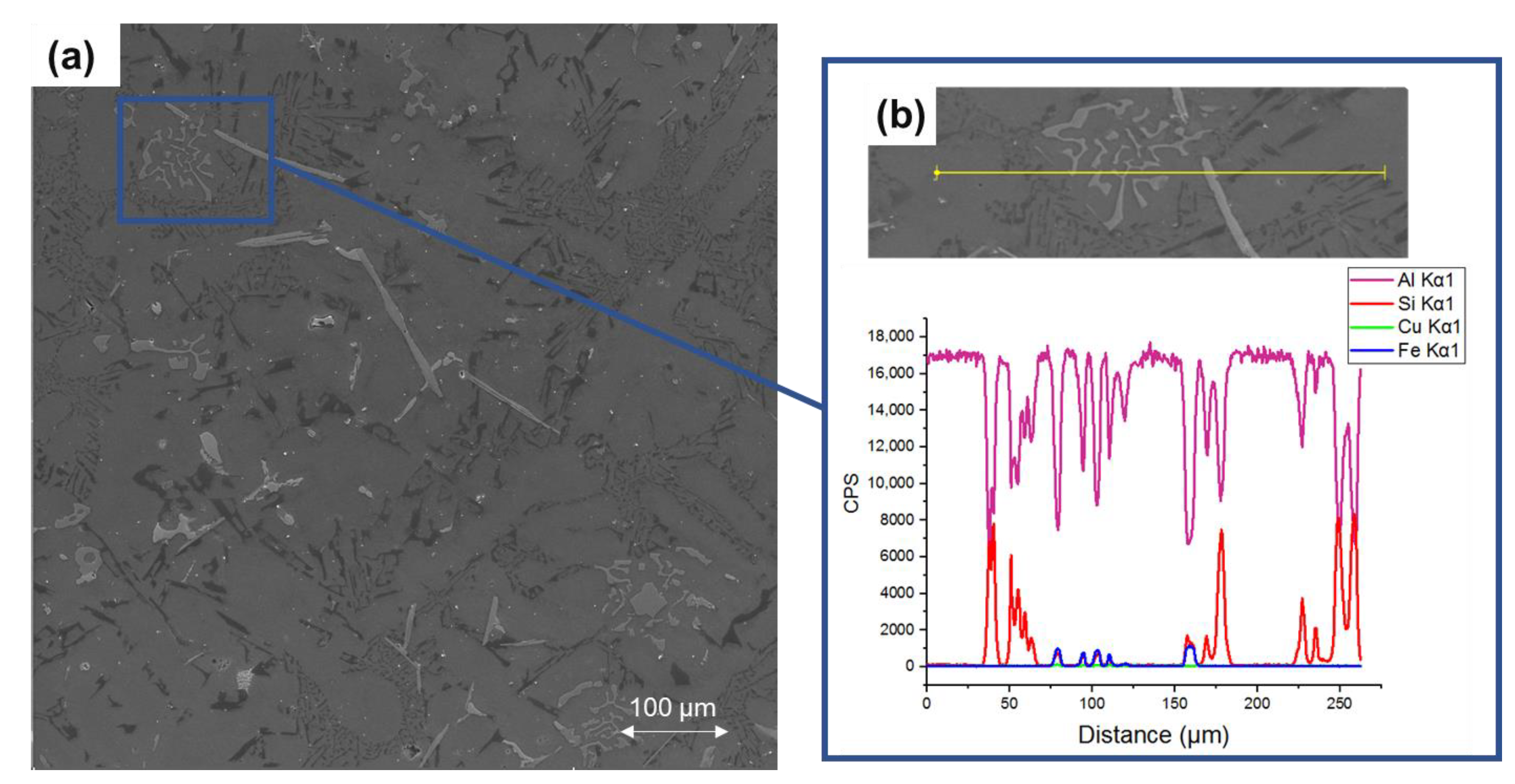

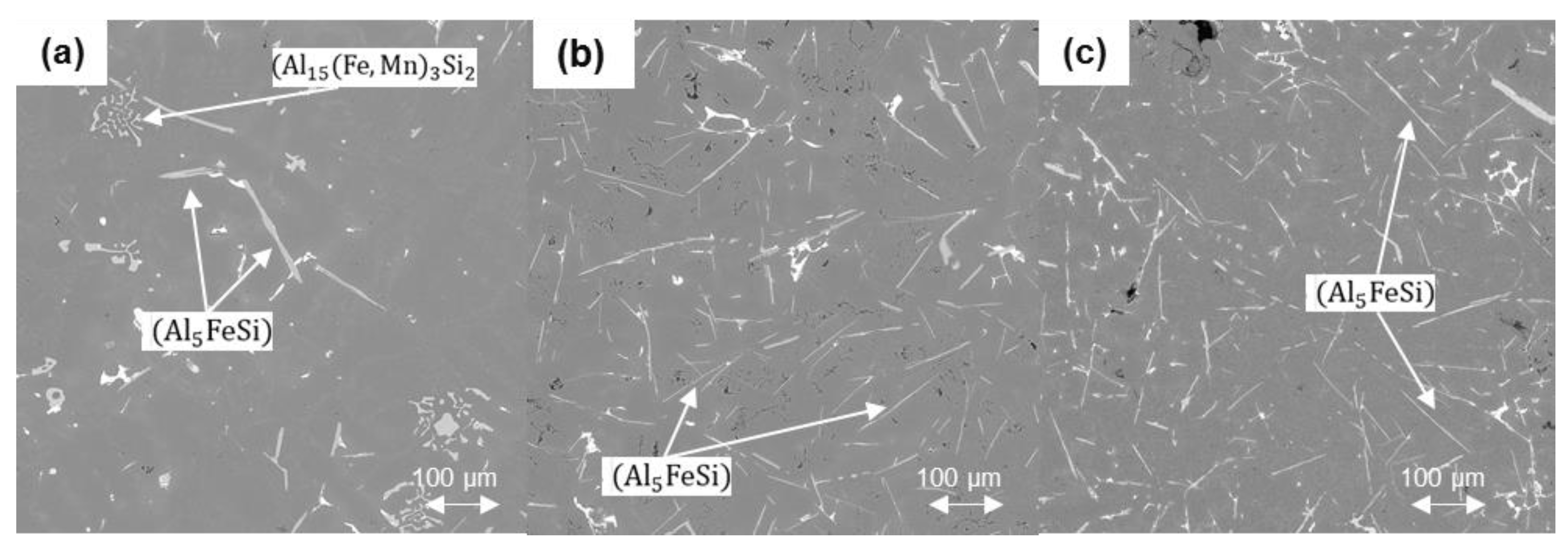
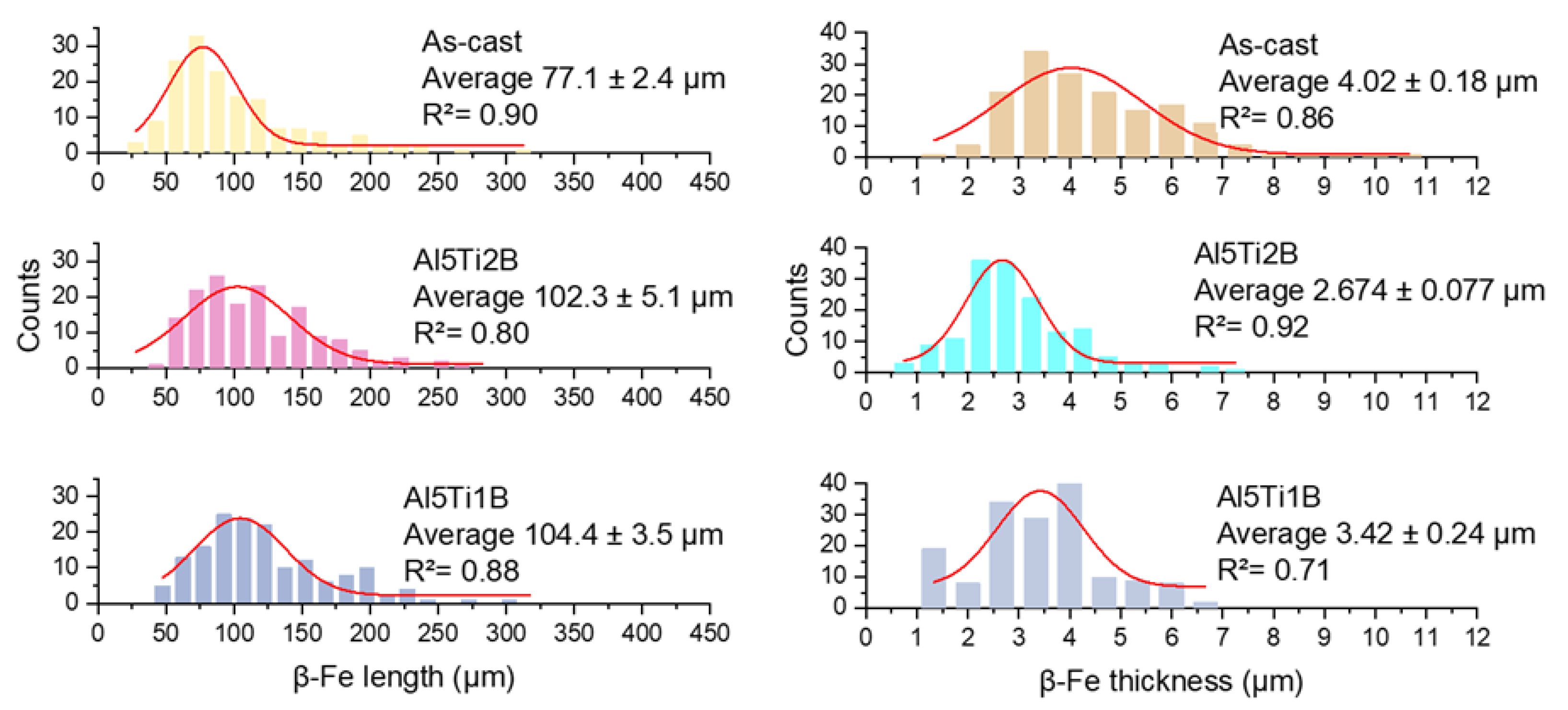
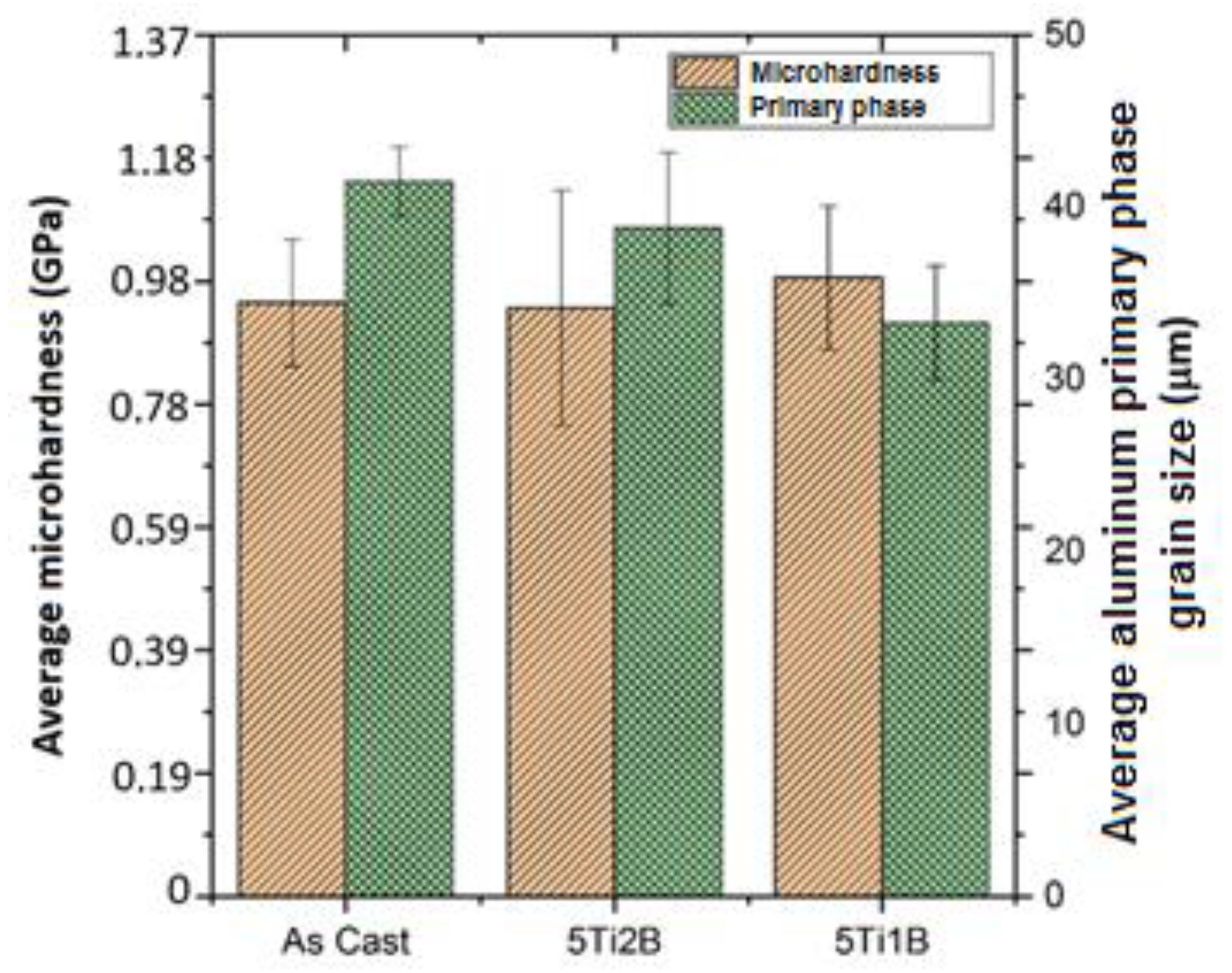
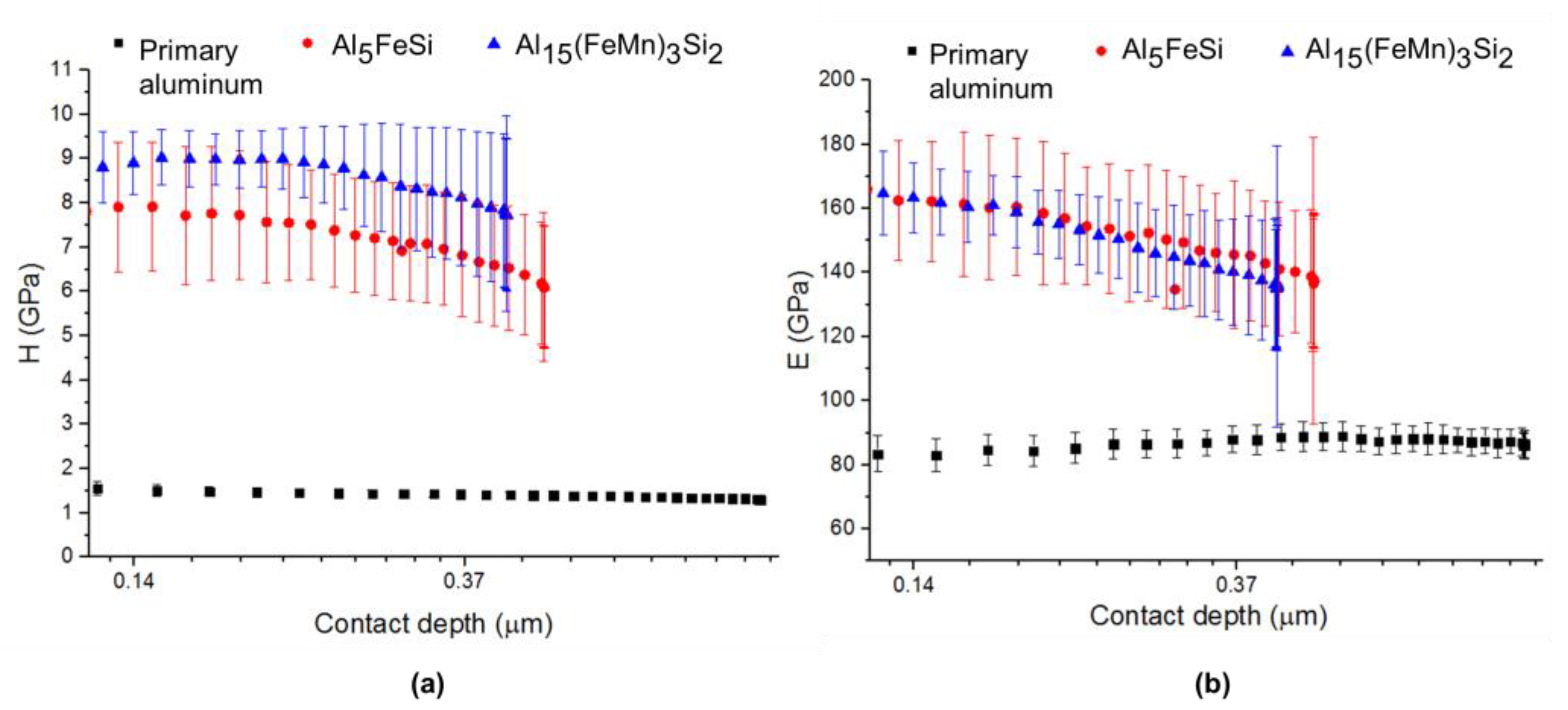
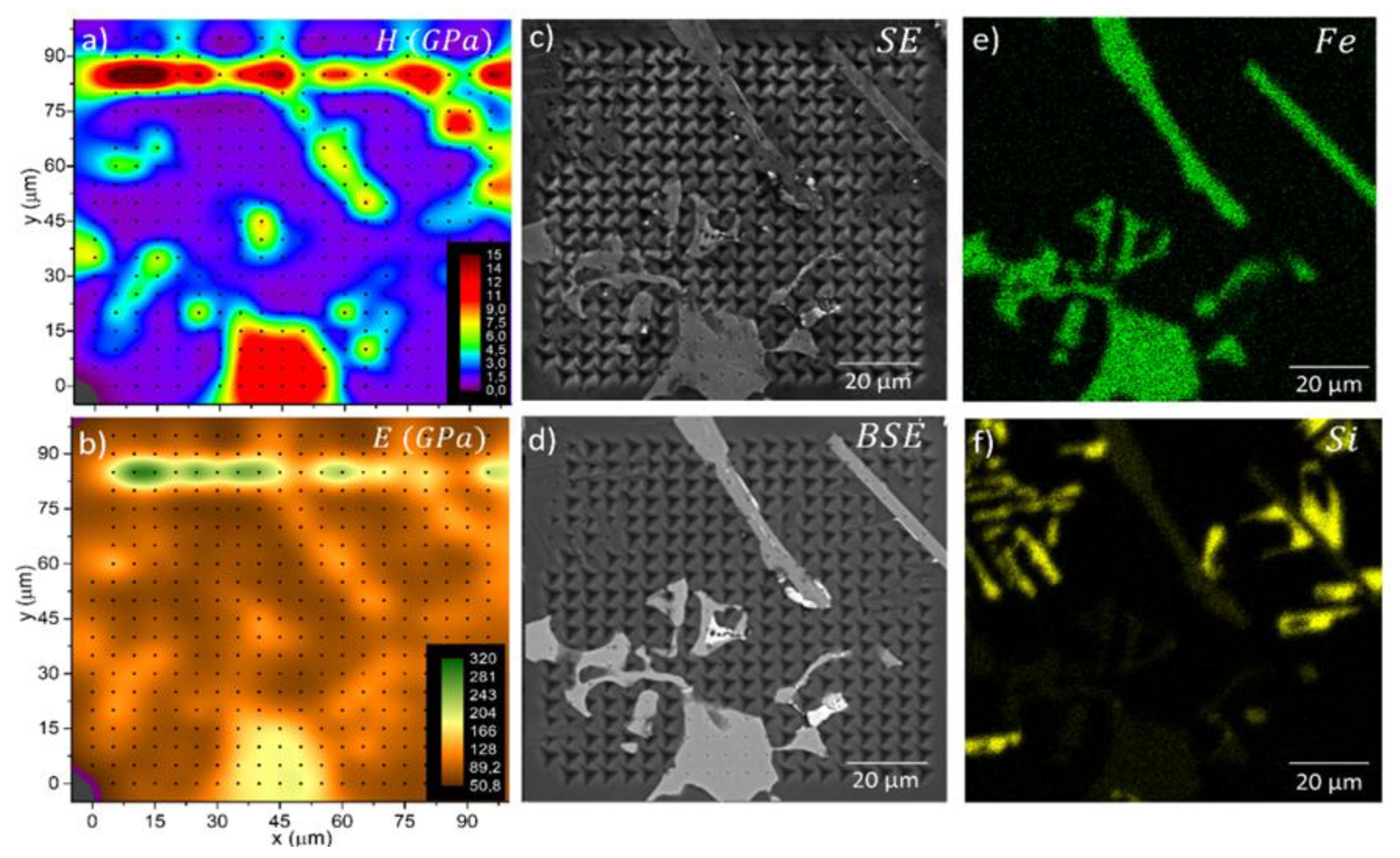
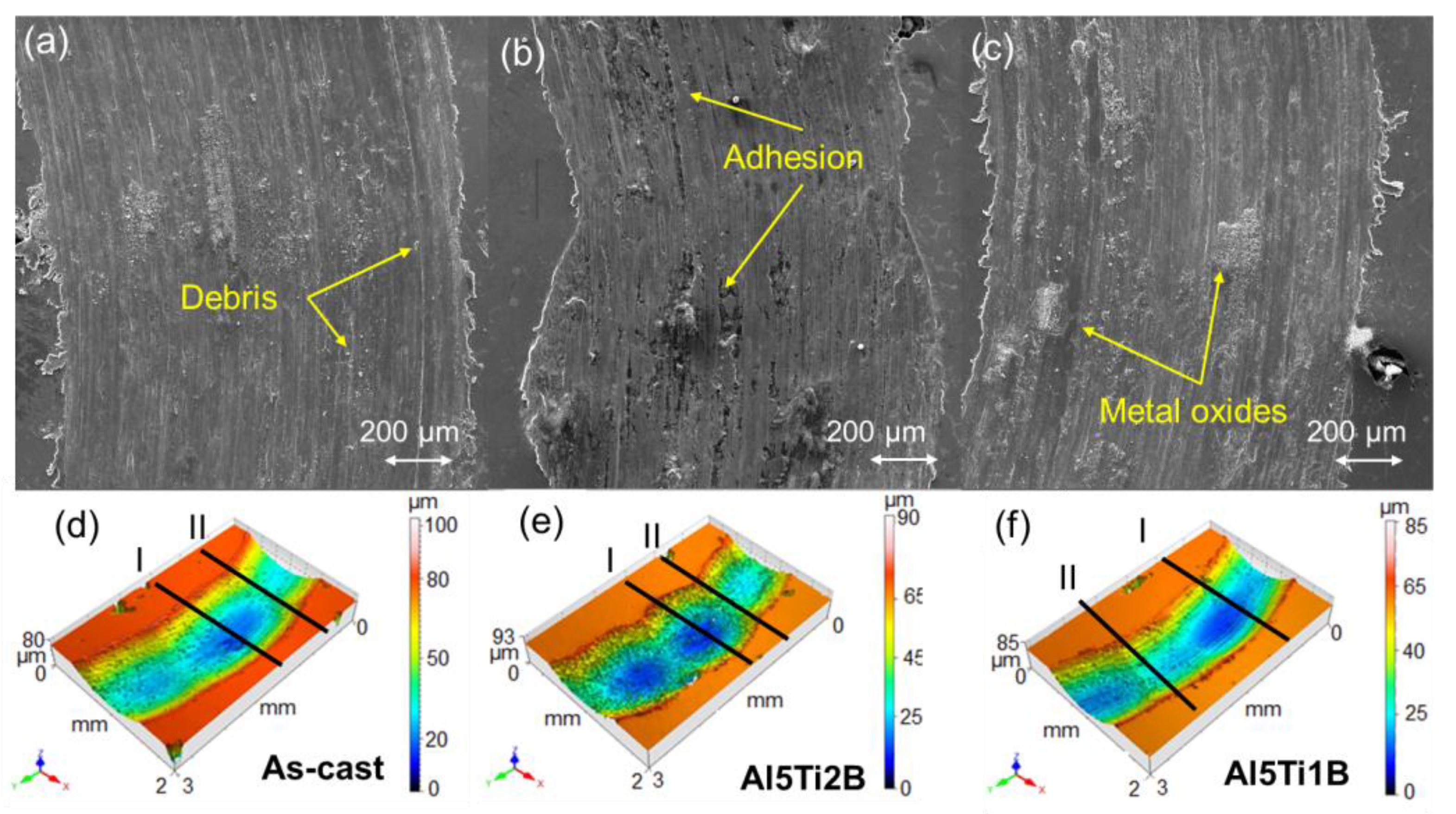


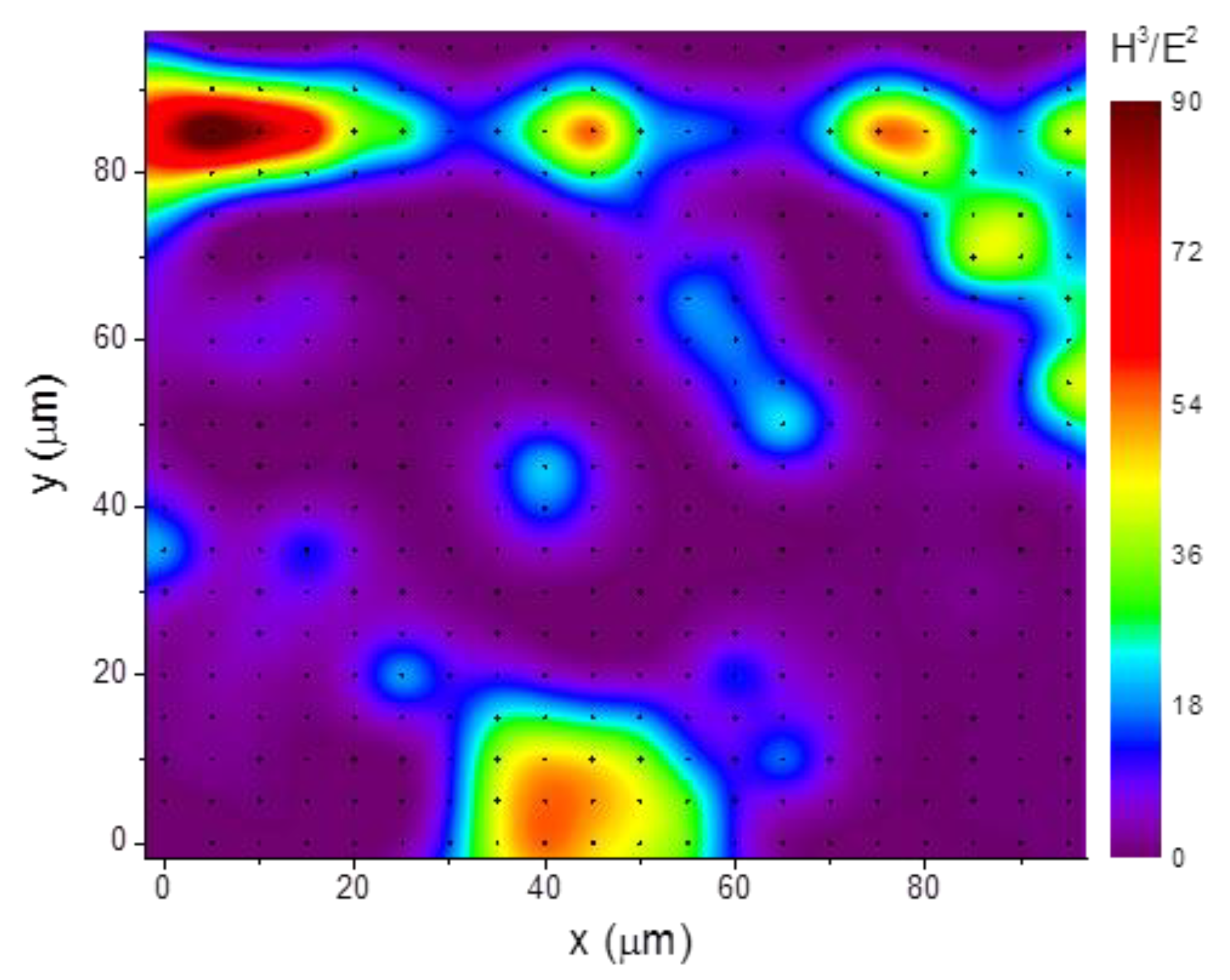
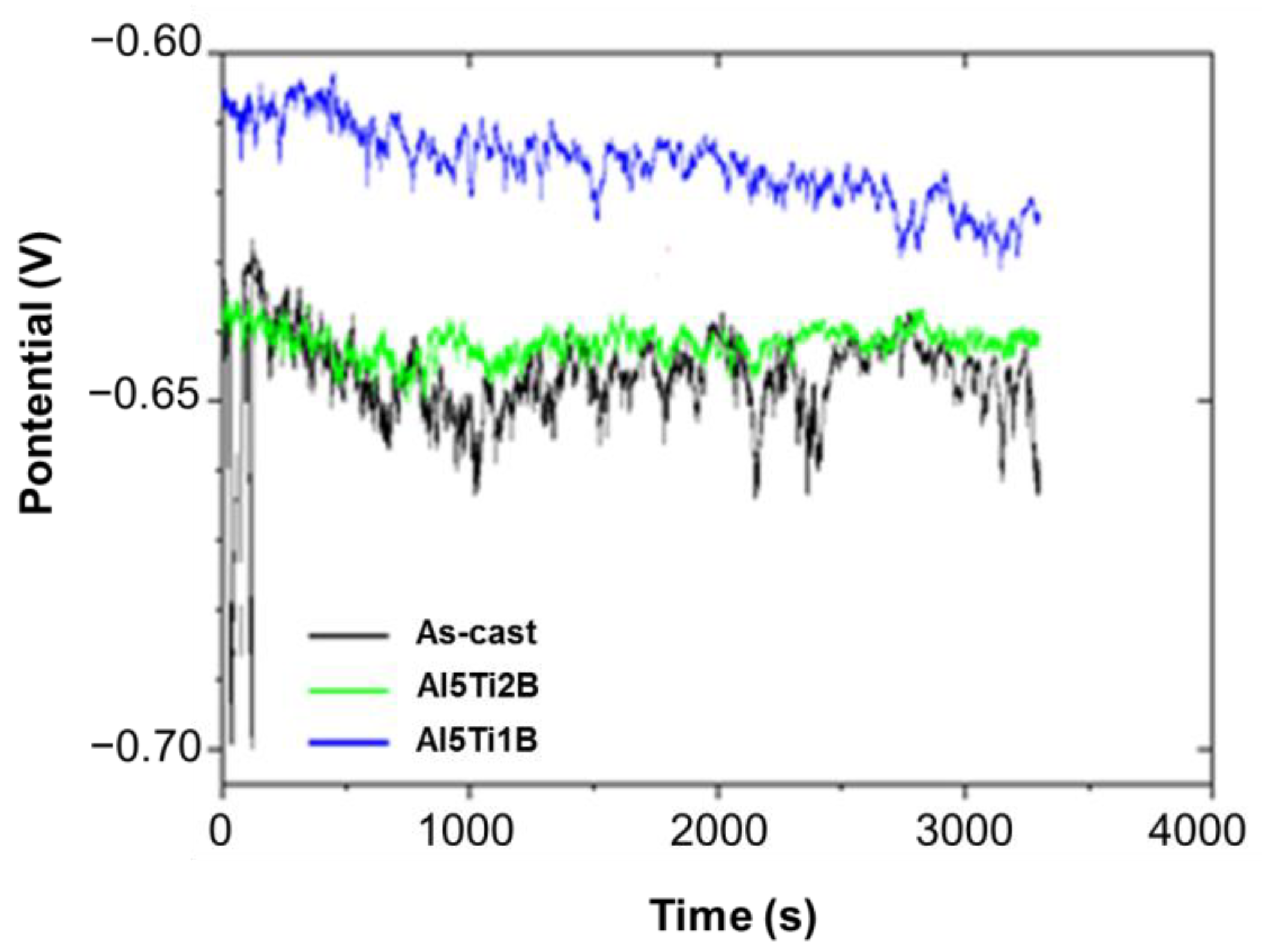
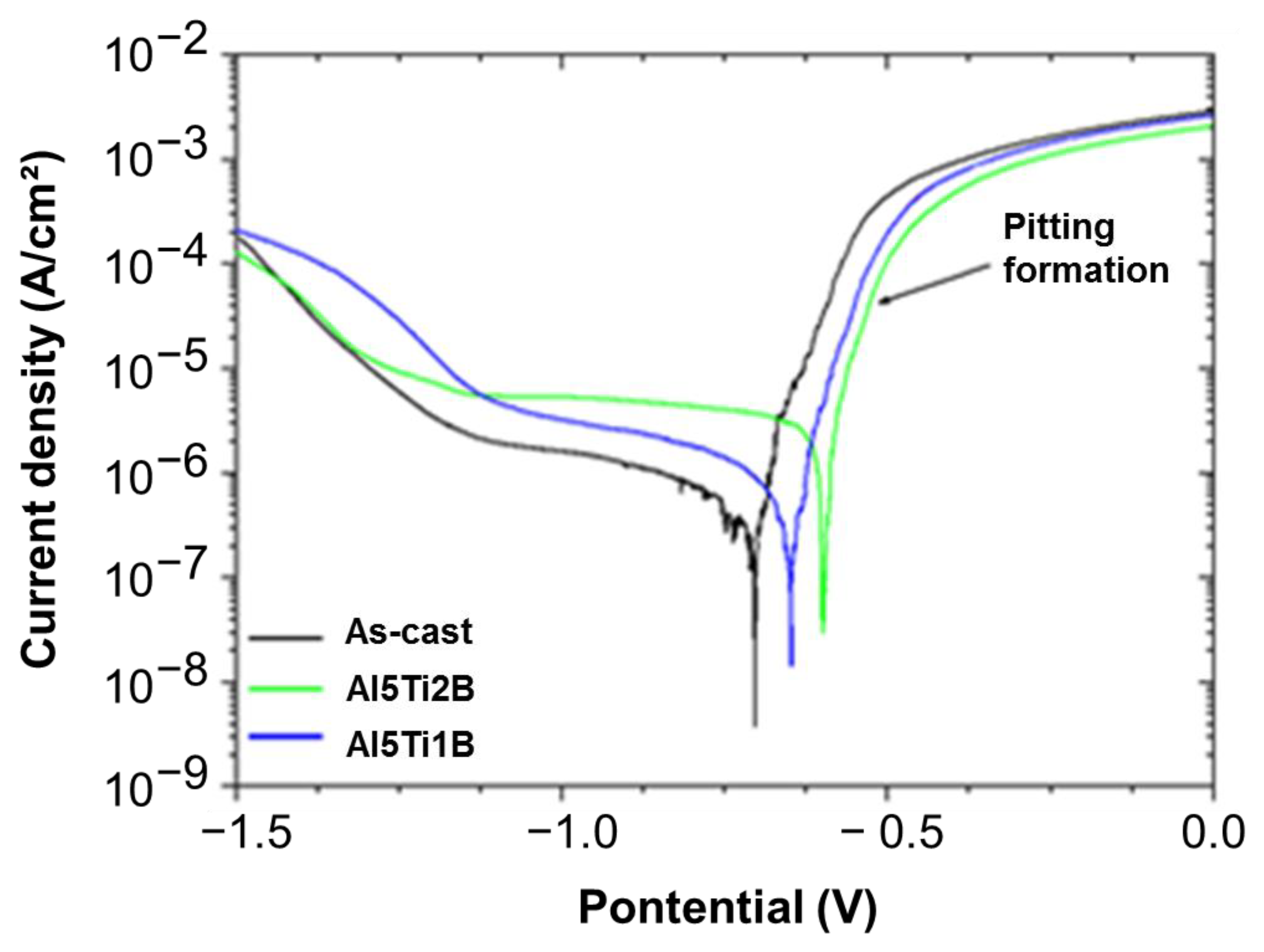

| Si | Fe | Cu | Mn | Mg | Zn | Ni | Cr | Pb | Ti | Sr |
|---|---|---|---|---|---|---|---|---|---|---|
| 8.734 | 0.895 | 2.757 | 0.183 | 0.252 | 0.993 | 0.121 | 0.025 | 0.063 | 0.059 | 0.001 |
| Castings Samples | Alloy A332 | Refiners | Modifier Sr | |
|---|---|---|---|---|
| Ti | B | |||
| As-cast | 99.98 | 0 | 0 | 0.02 |
| Al5Ti2B | 92.98 | 5 | 2 | 0.02 |
| Al5Ti1B | 93.98 | 5 | 1 | 0.02 |
| Diameter of Path (mm) | Ball Diameter (mm) | Sliding Speed (m/s) | Load (N) | Number of Cycles |
|---|---|---|---|---|
| 8 | 6 | 0.1 | 3 | 15,000 |
| Sample Material | As-Cast | Al5Ti2B | Al5Ti1B |
|---|---|---|---|
| Relative wear resistance | 1 | 1.359 | 1.353 |
| Sample | Rp (Ω) | Ba | Bc | Icorr (µA/cm2) | Ecor (V) | Eocp (V) | η (V) | Corrosion Rate (mm/year) |
|---|---|---|---|---|---|---|---|---|
| As Cast | 14,315 | 0.06434 | 1.2661 | 3.29 | −0.7039 | −0.6610 | 0.0429 | 0.034 |
| Al5Ti2B | 7305.6 | 0.05561 | 1.8894 | 12.1 | −0.6015 | −0.6408 | −0.0393 | 0.126 |
| Al5Ti1B | 10,653 | 0.05926 | 0.8459 | 1.85 | −0.6484 | −0.6237 | 0.0247 | 0.019 |
Disclaimer/Publisher’s Note: The statements, opinions and data contained in all publications are solely those of the individual author(s) and contributor(s) and not of MDPI and/or the editor(s). MDPI and/or the editor(s) disclaim responsibility for any injury to people or property resulting from any ideas, methods, instructions or products referred to in the content. |
© 2022 by the authors. Licensee MDPI, Basel, Switzerland. This article is an open access article distributed under the terms and conditions of the Creative Commons Attribution (CC BY) license (https://creativecommons.org/licenses/by/4.0/).
Share and Cite
Arendarchuck, B.E.; Mayer, A.R.; de Oliveira, W.R.; Pukasiewicz, A.G.M.; Lourençato, L.A.; Fals, H.D.C.; Martínez-Cámara, E. Effect of Ti-B Grain Refiners on Wear and Corrosion of the A332 Alloy with Sr Modification. Appl. Sci. 2023, 13, 430. https://doi.org/10.3390/app13010430
Arendarchuck BE, Mayer AR, de Oliveira WR, Pukasiewicz AGM, Lourençato LA, Fals HDC, Martínez-Cámara E. Effect of Ti-B Grain Refiners on Wear and Corrosion of the A332 Alloy with Sr Modification. Applied Sciences. 2023; 13(1):430. https://doi.org/10.3390/app13010430
Chicago/Turabian StyleArendarchuck, Bruno E., Andre R. Mayer, Willian R. de Oliveira, Anderson G. M. Pukasiewicz, Luciano A. Lourençato, Hipolito D. C. Fals, and Eduardo Martínez-Cámara. 2023. "Effect of Ti-B Grain Refiners on Wear and Corrosion of the A332 Alloy with Sr Modification" Applied Sciences 13, no. 1: 430. https://doi.org/10.3390/app13010430
APA StyleArendarchuck, B. E., Mayer, A. R., de Oliveira, W. R., Pukasiewicz, A. G. M., Lourençato, L. A., Fals, H. D. C., & Martínez-Cámara, E. (2023). Effect of Ti-B Grain Refiners on Wear and Corrosion of the A332 Alloy with Sr Modification. Applied Sciences, 13(1), 430. https://doi.org/10.3390/app13010430








